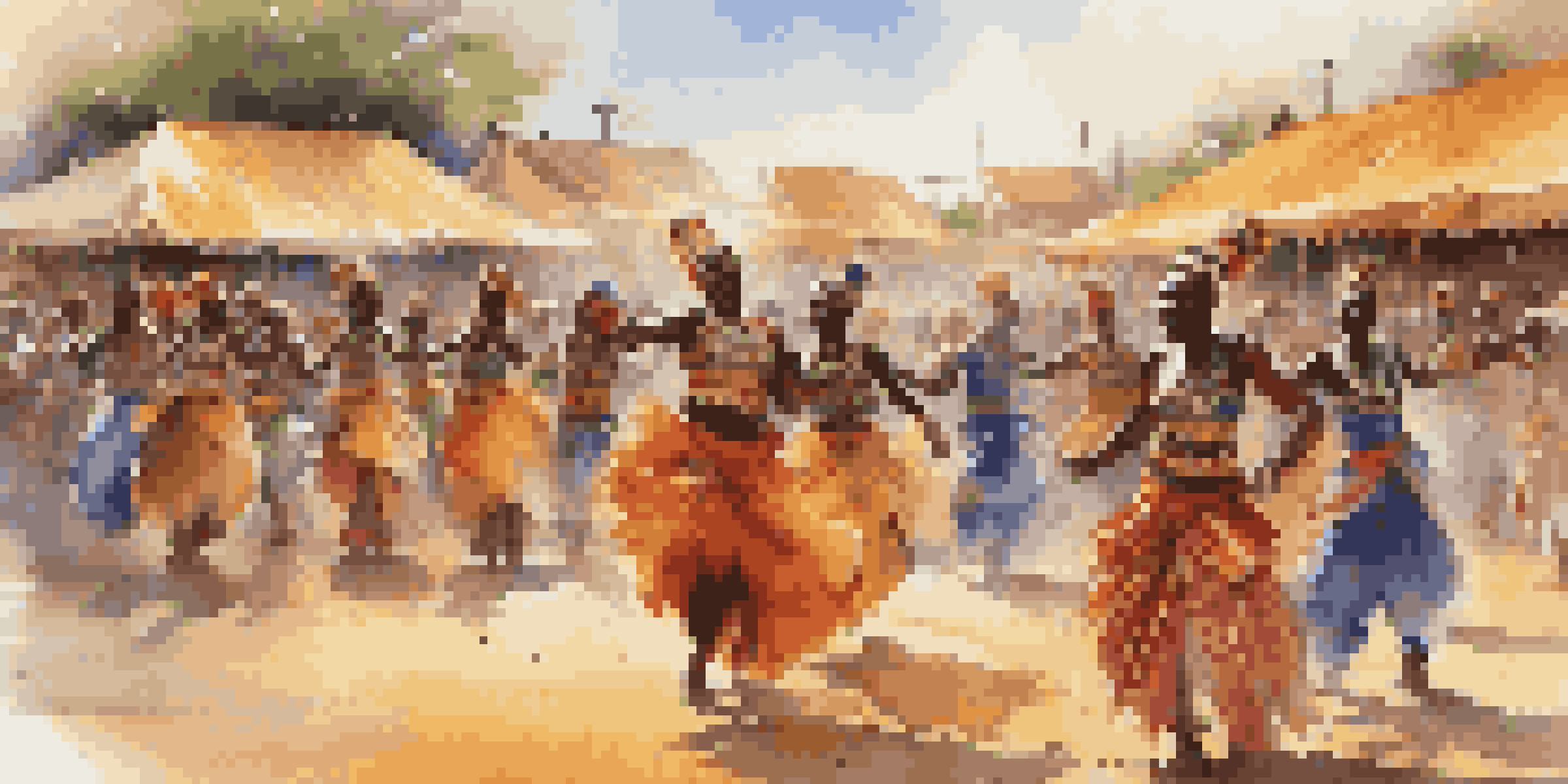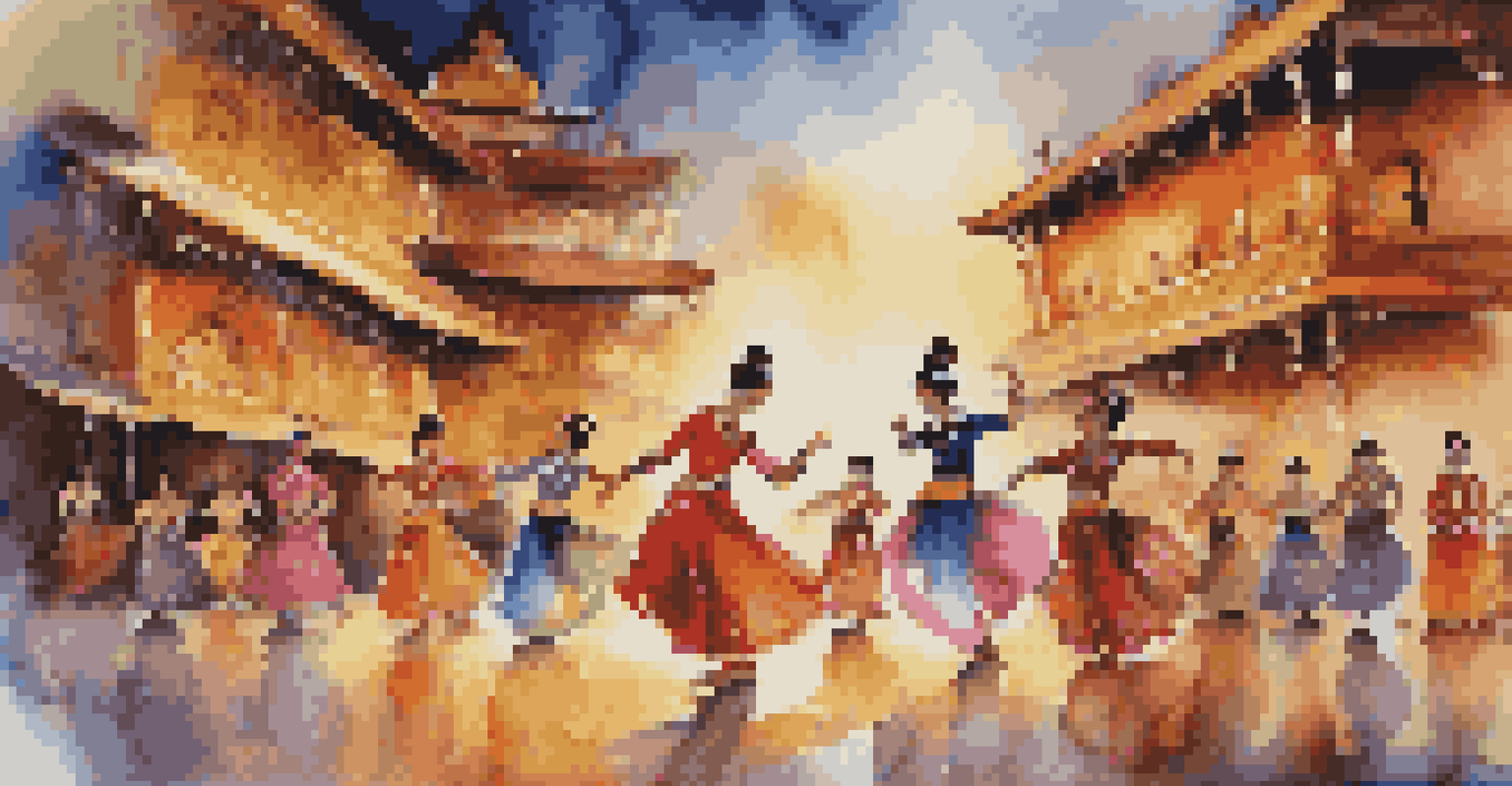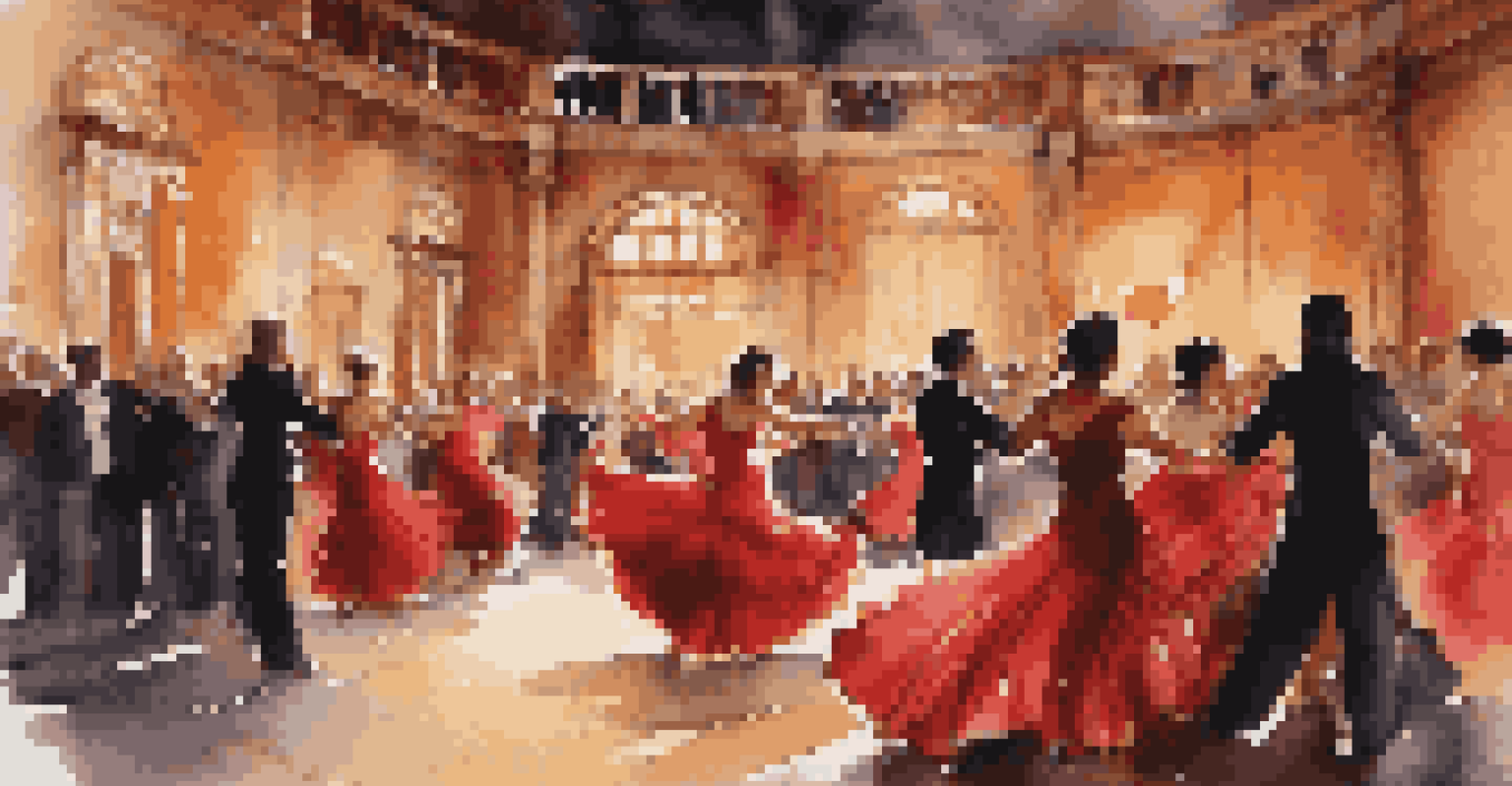Celebrating Diversity: Dance Festivals Across Continents

Dance: A Universal Language Connecting Cultures
Dance is often described as a universal language, transcending borders and uniting people from diverse backgrounds. At its core, dance expresses emotions and stories that resonate with everyone, regardless of their culture. It serves as a powerful medium for communication, allowing individuals to share their heritage and experiences through movement.
Dance is the hidden language of the soul.
Across continents, traditional dances showcase the unique customs and histories of various communities. For instance, the vibrant samba of Brazil reflects its rich Afro-Brazilian roots, while the intricate Bharatanatyam from India tells ancient stories through graceful choreography. These performances not only entertain but also educate, offering a glimpse into the cultural fabric of societies.
As we celebrate diversity through dance, we foster understanding and appreciation for different cultures. Festivals that highlight these art forms invite participation and engagement, breaking down barriers and encouraging connections between people from all walks of life.
The Thriving Dance Festival Scene in Africa
Africa is home to a multitude of dance festivals, each showcasing the rich cultural heritage of its people. One notable event is the Harare International Festival of the Arts in Zimbabwe, where traditional and contemporary dance forms merge, creating a vibrant atmosphere. This festival not only highlights local talent but also invites international performers, making it a melting pot of artistic expression.

Another significant festival is the Festival of African Culture in Nigeria, which celebrates traditional dances like the Ekombi and the Bata. These dances often embody the spiritual and communal aspects of African life, bringing communities together in joyous celebration. Through captivating performances, attendees can witness the stories and traditions that have been passed down through generations.
Dance Unites Global Cultures
Dance serves as a universal language, connecting people across diverse backgrounds through shared emotions and stories.
Dance festivals in Africa are more than just artistic showcases; they are vital for cultural preservation and community bonding. By supporting these events, we contribute to the empowerment of local artists and the safeguarding of diverse cultural practices.
Asia: Where Tradition Meets Modernity in Dance
In Asia, dance festivals often blend traditional practices with contemporary influences, creating a dynamic cultural landscape. The Singapore Arts Festival, for example, features a mix of classical dances like Kathak from India and modern interpretations, allowing for a rich exchange of ideas and styles. This fusion showcases the evolving nature of dance, reflecting the changing identities of communities.
The dance is a poem of which each movement is a word.
Similarly, the Hong Kong Arts Festival invites local and international artists to participate, highlighting diverse dance forms from ballet to street dance. This inclusivity encourages collaboration and innovation, inspiring performers to push creative boundaries. It also provides audiences with a unique opportunity to experience the spectrum of dance styles in one venue.
These festivals serve as platforms for dialogue and understanding, breaking stereotypes and fostering respect for different cultures. By celebrating the diversity of dance, we can appreciate the artistry and talent that exists within Asia and beyond.
Europe's Rich Tapestry of Dance Festivals
Europe boasts a plethora of dance festivals that celebrate both traditional and contemporary styles, reflecting its rich cultural diversity. The Edinburgh Festival Fringe in Scotland is one of the largest arts festivals in the world, featuring performances from various dance genres, including flamenco, ballet, and hip-hop. This diversity not only enriches the festival but also attracts a global audience eager to witness the variety of artistic expression.
In Spain, the Bienal de Flamenco in Seville is a prime example of how dance can encapsulate the spirit of a nation. This festival showcases the passionate and emotive nature of flamenco, highlighting its roots in Andalusian culture. Through workshops and performances, attendees can immerse themselves in this captivating dance form, gaining a deeper understanding of its significance.
Vibrant Festivals Celebrate Diversity
Dance festivals around the world showcase traditional and contemporary forms, fostering cultural appreciation and understanding.
European dance festivals not only entertain but also act as cultural exchanges, fostering connections between artists and audiences. By celebrating different dance forms, these events promote inclusivity and appreciation for the diverse tapestry of cultures across the continent.
North America's Eclectic Dance Festival Culture
North America is a hub for diverse dance festivals that celebrate the continent's multicultural landscape. The American Dance Festival, held annually in Durham, North Carolina, showcases both established and emerging choreographers, offering a platform for innovative works. This festival emphasizes the importance of creativity and collaboration, inviting artists from various backgrounds to share their unique perspectives.
In addition to contemporary dance, festivals like the Powwow in the U.S. and Canada highlight Indigenous dance traditions, allowing for cultural revitalization and education. These events serve as important gatherings for Indigenous communities, fostering pride in their heritage while sharing their rich traditions with wider audiences.
Dance festivals in North America are instrumental in promoting inclusivity and understanding among diverse populations. By embracing various dance forms, these events invite everyone to celebrate cultural differences and come together in appreciation of the art of movement.
Oceania's Unique Dance Festivals and Traditions
In Oceania, dance festivals play a crucial role in preserving and promoting Indigenous cultures. The Te Matatini Festival in New Zealand is a prime example, showcasing the powerful art of kapa haka, which combines singing, dancing, and chanting. This festival not only celebrates Māori culture but also educates attendees about its historical significance, fostering respect and understanding.
Australia's National Indigenous Music Awards also highlight the importance of traditional dance in storytelling. Indigenous performers share their narratives through movement, connecting audiences with their rich cultural heritage. These performances are not just entertainment; they are a vital part of cultural preservation and identity.
Technology Enhances Dance Experiences
The integration of technology in dance festivals opens new avenues for audience engagement and artistic expression.
Through these celebrations, Oceania demonstrates the power of dance in bridging cultural gaps and fostering a sense of belonging. By embracing and sharing these unique traditions, we contribute to a more inclusive world that values and respects diversity.
The Role of Technology in Dance Festivals
In today's digital age, technology plays an increasingly significant role in dance festivals worldwide. Live streaming and social media platforms allow festivals to reach global audiences, making it easier for people to participate and engage with diverse cultures from their homes. This accessibility opens up new avenues for collaboration and idea exchange among artists and audiences alike.
Moreover, technology enhances the festival experience itself, with innovative stage designs, virtual reality performances, and interactive installations. These advancements not only elevate the artistic presentation but also create immersive experiences that resonate with attendees. Technology thus enriches the narrative of dance, bringing stories to life in new and exciting ways.

As we celebrate diversity in dance, it's essential to embrace the role of technology in fostering connections and expanding reach. By integrating digital tools, dance festivals can continue to evolve and adapt, ensuring that the celebration of cultural diversity remains vibrant and relevant.
The Future of Dance Festivals: Embracing Diversity
The future of dance festivals lies in their ability to adapt and embrace the ever-evolving tapestry of global cultures. As societies become more interconnected, these festivals have the opportunity to showcase a broader range of dance forms and traditions, celebrating not just established styles but also emerging voices and movements. This evolution invites audiences to explore and appreciate the richness of diverse cultures.
Furthermore, the emphasis on inclusivity and representation is becoming increasingly important in festival programming. By prioritizing diverse artists and performances, festivals can foster a sense of belonging for all attendees, breaking down barriers and encouraging dialogue between cultures. This approach not only enriches the festival experience but also contributes to social change.
As we look to the future, dance festivals will continue to be vital platforms for celebrating diversity. By uniting people through the art of movement, we can create a more harmonious world that values and respects the unique stories each culture has to share.